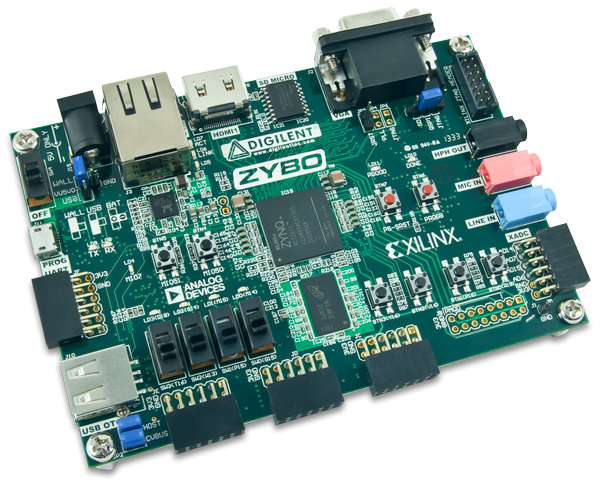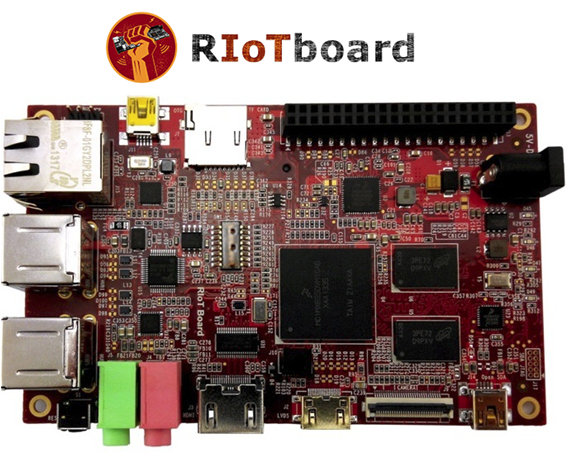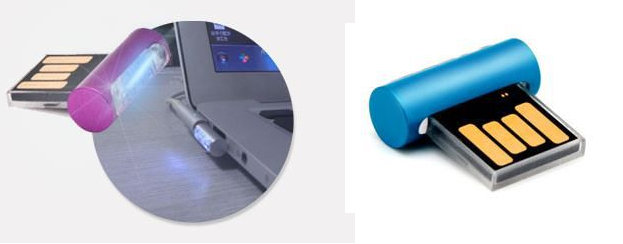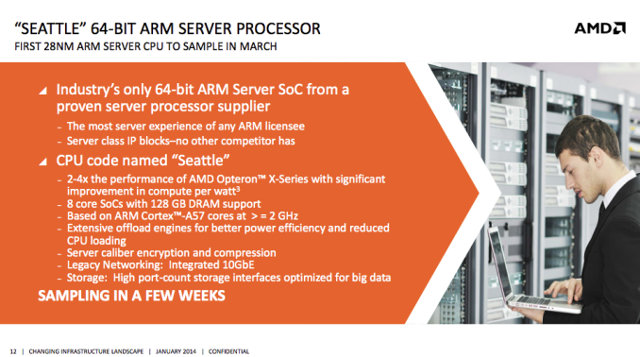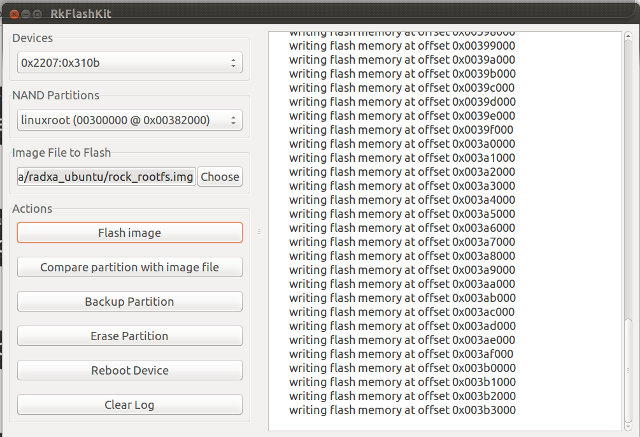Digilent ZYBO (ZYnq BOard) is a low cost development board powered by Xilinq Zynq-7010 SoC featuring a dual core ARM Cortex A9 processor and FPGA fabric. It’s using the same SoC as MicroZed, is in the same price range as it costs $189 ($125 for academic purpose), but adds video interfaces, namely bi-directional HDMI and VGA, that are not available in MicroZed. It does come however with less RAM (512 MB vs 1GB). Digilent ZYBO specifications: SoC – Xilinx ZYNQ XC7Z010-1CLG400C dual core Cortex A9 processor + FPGA with 28K Logic Cells (~430K ASIC gates). System Memory – 512MB x32 DDR3 w/ 1050Mbps bandwidth Storage – 128Mb Serial Flash w/ QSPI interface, MicroSD slot for Linux file system, EEPROM programmed with 48-bit globally unique EUI-48/64™ compatible identifier. Video I/O – Dual-role (Source/Sink) HDMI port, 16-bits per pixel VGA output port Audio I/O – Audio codec with headphone out, microphone and […]
$74 RIoTBoard Development Board Features Freescale i.MX 6Solo
RIoTBoard, which stands for “Revolutionizing the Internet of Things Board”, is a new Android & GNU/Linux development board sold by Element14 /Newark powered by Freescale i.MX6Solo Cortex A9 processor. The board also features 1GB DDR3 RAM, 4GB eMMC and plenty of ports including Gb Ethernet, HDMI, and more. The board can be used to design netbooks , nettops, mobile internet devices (MIDs), PDAs, portable media players (PMP) with HD video capability, portable navigation devices (PNDs), industrial control and test and measurement (T&M), and single board computers (SBCs). RIoTBoard specifications: SoC – Freescale i.MX 6Solo ARM Cortex A9 MPCore Processor @ 1 GHz with Vivante GC880 and GC320 GPUs for 3D & 2D graphics, and HD video processing unit. System Memory – 1GB DDR3 RAM Storage – 4GB eMMC, microSD and SD card slots Video Output – HDMI, LVDS, and parallel RGB interfaces Audio I/O – Analog headphone/microphone, 3.5mm audio jack […]
Cute Embedded Nonsense Hacks, Nouveau Driver for Tegra K1, and Android Defaults to ART
There’s been some news at the end of this week that may not warrant a full article, but are still fun and/or interesting nonetheless: comments by the lead developer of Fedora ARM led to “Cute Embedded Nonsense” meme on Google+, preliminary commit for open source drivers for Tegra K1’s GPU, and Android Open Source Project defaults to ART instead of Dalvik. If you have a Google+ account, and circled a few people involved in ARM Linux, you must have seen a few postings about “Cute Embedded Nonsense Hacks” in your feed. It all started when Jon Masters posted about Red Hat’s ARM SBSA platform requirements, and in particular one comment that reads: I am all for people installing their own kernels if they want to. I support aggressively defined standard platforms (not cute embedded nonsense hacks) but not locked platforms. You can keep both parts when it breaks, of course. […]
Linaro 14.01 Release with Linux Kernel 3.13 and Android 4.4.2
The first release of the year, Linaro 14.01, is now out with Linux Kernel 3.13 (baseline), Linux Kernel 3.10.28 (LSK), Android 4.4.2, and Ubuntu Linaro 14.01. The most important part of this release is support for Arndale Octa, which makes big.LITTLE processing code available to a low cost platform. Android 4.4.x is now on par with Android 4.3 in terms of support. Linaro has also decided to provide quarterly stable released with GCC, and Linaro GCC 4.7-2014.01 is the first quarterly stable release with the next one planned with Linaro 14.04. Here are the highlights of this release: Linaro Stable Kernel (LSK) 3.10.28-2014.01 with latest version of GTS patch set for big.LITTLE, and Android support Linux Linaro 3.13-2014.01: gator version 5.17 updated linaro-android-3.13-merge topic by John Stultz, the “Revert “PM / Sleep: Require CAP_BLOCK_SUSPEND to use wake_lock/wake_unlock” patch included uprobes v4 updated big-LITTLE-pmu topic from ARM Landing Team (LT) updated […]
RYVAL Elf Could Be the World’s Smallest USB Flash Drive
Hexino, a French company selling “fashion technology” under the brand RYVAL, may be offering the smallest USB flash drives available today with RYVAL Elf. This tiny mass storage device measure 1.8 cm x 1.8 cm x 0.68 cm, weights only 2 grams, and is available with capacities of 8GB, 16GB, or 32GB. The specifications listed on the company’s website are as follows: USB 2.0 compatible with Windows Vista, 7 and 8 Write speed – Up to 4 MB/s Read speed – Up to 12 MB/s Weight – 2 grams Dimensions – 18 mm x 18 mm x 6.8 mm Capacity – 8 GB to 32 GB Colors – Blue, Pink, and Green Material – Aluminium They only mention compatibility with Windows, but I don’t see why it could not work with Mac, Android, and Linux based devices and computers. It’s small enough to replace microSD cards for permanent storage expansion, […]
AMD Opteron A1100 Server SoCs Feature 4 to 8 ARM Cortex A57 Cores
A few months ago, AMD published a roadmap showing AMD “Seattle” Server CPUs based on ARMv8 64-bit architecture were planned for H2 Q2014. The company has now announced the first series of processors that will be based on ARM Cortex A57: AMD Opteron A1100 Series, as well as the corresponding development platform at the Open Compute Project Summit in San Jose, California. Key features of AMD Opteron A1100 Series processors: 4 or 8 core ARM Corte-A57 processors Up to 4 MB of shared L2 and 8 MB of shared L3 cache Configurable dual DDR3 or DDR4 memory channels with ECC at up to 1866 MT/second Up to 4 SODIMM, UDIMM or RDIMMs 8x lanes of PCI-Express Gen 3 I/O 8x Serial ATA 3 ports 2x 10 Gigabit Ethernet ports ARM TrustZone technology for enhanced security Crypto and data compression co-processors On the software side, the company mentionned it is a […]
How to Install XBMC on D-Link Boxee Box
D-Link Boxee Box is a Linux based media player powered by Intel Atom CE4100 processor that became available in 2010, and features a dual sided RF remote / QWERTY keyboard that probably inspired many of the air mouse that are available today. The box features many of the ports and connectors that are available on most Android STB today, namely an HDMI port, an optical S/PDIF) out, a stereo analog audio out, Ethernet and 802.11n Wi-Fi, two USB ports, and an SD card slot. Many people however got disappointed with the firmware at launch time, and even if subsequent firmware updates have improved the user experience, some people have considered it was worth the effort to port XBMC to the device. Myles McNamara wrote the instructions to install XBMC on D-Link Boxee Box. I’ll summarize the steps below, and it appears to be relatively easy. Installing Boxee+Hacks to gain root […]
Getting Started with Raxda Rock – How to Generate and Flash Ubuntu Saucy Server and Desktop Images
I’ve already written a guide showing how to build and install Android in Radxa Rock. Today I’m going to build the Linux kernel, generate a Ubuntu server images based latest Ubuntu Linaro server release, flash the image to the NAND flash, and show how to install LXDE or XFCE desktop environment. If you are just interested in installing one of the latest supported images, you can download Android, dual boot (Android/Ubuntu), Ubuntu ALIP, and Router images for Radxa Rock @ http://dl.radxa.com/rock/images/, and skip “build” and “generate” instructions, and just follow the flashing instructions below. All steps in this tutorial will be done in Ubuntu 13.10, and lots of the instructions below follow hwswbits blog and Ubuntu Radxa Wiki. Build the Linux kernel Let’s start by building the Linux kernel. I’m assuming you’ve already install development tools in Ubuntu (e.g. apt-get install build-essentials). You can refer to the list at the beginning […]


